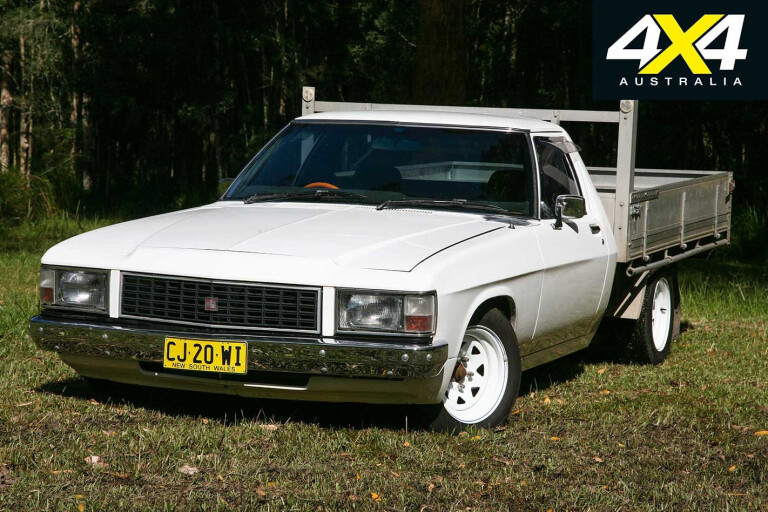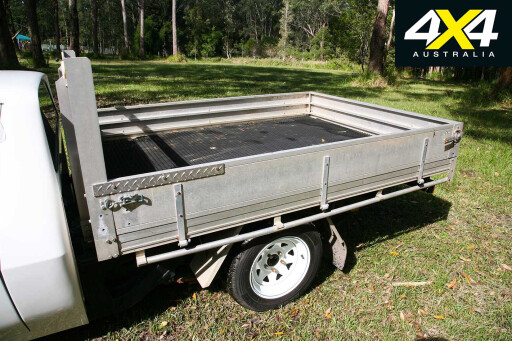
From a young age I salivated, dreamt and perved – call it what you will – at Holden Overlanders built in the mid to late 1970s. They seemed to have that special ‘something’ about them that implied style, macho and ruggedness, much like the iconic Camel Trophy days and The Marlboro Man, along with a go-anywhere appeal.
Fast forward many years – almost 30 since I fist-pumped at passing my driver’s licence test – and I still had a hankering to own something different, something outside the box, something not many others own. I still wanted an Overlander to park next to my current, moderately-modified V8 Troopy.
.jpg ) I’ve been lucky enough to meet up with a few fellas that own these much sought-after 4x4s, and to say they love ’em is an understatement. Whether they are utes, station wagons or panel vans, their owners rarely part with them. If they do, they seem to be fetching higher and higher prices – way out of my price league.
I’ve been lucky enough to meet up with a few fellas that own these much sought-after 4x4s, and to say they love ’em is an understatement. Whether they are utes, station wagons or panel vans, their owners rarely part with them. If they do, they seem to be fetching higher and higher prices – way out of my price league.
Add to that, being the age they are (getting close to the 40-year mark), and the fact that most cars of that era have well and truly jumped on the rust train, I figured I’d have a go at making my own.
Now, in all fairness to Arthur Haywood – the incredibly clever fella with the foresight and engineering skills to create the original Overlander vehicles – the tools, methods and vehicle parts he had available in the 70s are a far cry from what we have these days.
.jpg ) He chose to fabricate a replacement chassis section at the front of then brand-new Holdens and graft in Dana diffs, gearboxes and transfer cases shipped on the slow boat from the States, along with custom leaf spring packs. All of which worked great back then.
He chose to fabricate a replacement chassis section at the front of then brand-new Holdens and graft in Dana diffs, gearboxes and transfer cases shipped on the slow boat from the States, along with custom leaf spring packs. All of which worked great back then.
Stepping forward in time, where we have coil springs loaded into relatively well-mannered road-going 4x4s with excellent off-road ability and a large choice of easily obtainable, high-powered engines, I figured, with the help of a few industry hands, I could whip up what I reckon is my ‘perfect’ 4x4 that would suit me and no one else but me.
.jpg ) What I want won’t be a show stopper at Summernats and it won’t knock over the King Pins at Tough Dog, Cliff Hanger or Winch Challenge-type competition events. What I want to build is my dream 4x4: capable off-road, equally capable of clocking up long on-road dirt and bitumen miles, bloody powerful and, most importantly, it will stand out like you know what on a dog.
What I want won’t be a show stopper at Summernats and it won’t knock over the King Pins at Tough Dog, Cliff Hanger or Winch Challenge-type competition events. What I want to build is my dream 4x4: capable off-road, equally capable of clocking up long on-road dirt and bitumen miles, bloody powerful and, most importantly, it will stand out like you know what on a dog.
It’ll be a capable daily driver, it’ll only need the usual maintenance schedule, and it’ll mix it with the best on difficult off-road tracks. I give you, The Tonner.
Yep, as you’ve copped an eyeful from the photos, it’s a standard two-wheel drive Holden one-tonner. It’s a bitza that’s registered as a 1977 HX, with a HZ chassis, HX body and a WB front end slapped on.
Originally it sported a six-cylinder with four-speed manual ’box, but, sometime in its mixed-up history, it had a mighty 308 and three-speed Trimatic with T-bar auto chucked in. There’s been a full respray and a bit of rust replacement panel work done prior to me laying down cash on it.
.jpg ) All up, while not a perfect specimen, it’s a pretty good example to kick-start my project.
All up, while not a perfect specimen, it’s a pretty good example to kick-start my project.
Why a one-tonner? Selfishness.
I love my utes and didn’t need or want more than a two-seater. So I won’t take the family on holidays in it and I won’t do the school drop-off with all four of my kids. I reckon the Tonner looks beaut and will offer a perfect rear end tray that can be left simple with a couple of boxes, a fridge and a swag; or be developed into a mighty touring machine, complete with removable canopy and rooftop tent.
Mechanically speaking, whatever four-wheel drive system I end up using, I’ll only have to fit the front two wheels under the mudguards of a one-tonner. The rear wheels will sit under the tray in no fixed position; unlike a wagon or panel van, where I would have to work more on the wheelbase to fit all four wheels in.
 I’ll not go ballistic with unengineerably long, gangly coil springs and I don’t want 44-inch boggers or unroadworthy componentry bolted on. Everything I do to my Tonner will be 100 per cent engineered, so it can be legally driven on our roads.
I’ll not go ballistic with unengineerably long, gangly coil springs and I don’t want 44-inch boggers or unroadworthy componentry bolted on. Everything I do to my Tonner will be 100 per cent engineered, so it can be legally driven on our roads.
Rego, insurance and any Mr Plod that deems it necessary for a ‘look over’ won’t cause me headaches or dramas. Yep, this project will cost me more to do it right via an engineer, but it will be worth it in the long run.
Converting this two-wheel drive one-tonner into a 4x4 will not be done like Arthur Haywood did in his day. Rather, I’ll choose a donor chassis and donor engine – with gearbox, diffs and suspension – to get what I want: power, articulation, low gearing for the rough stuff, long legs for the lonely outback roads, and reliability.
 There are plenty of challenges facing this build from the get-go, and, while I have a few ideas of the path I’ll follow, some of it depends on initial discussions with the engineer.
There are plenty of challenges facing this build from the get-go, and, while I have a few ideas of the path I’ll follow, some of it depends on initial discussions with the engineer.
Basically, anything he vetoes gets slashed from my plans. If he gives me the nod, then I’ll start cutting, welding and spending my hard-earned. Admittedly, I could have purchased just a cabin instead of a complete, registered, driveable vehicle, but I reckon that would have added a heap more time sourcing parts and potentially cost more in the long run.
My plan was to buy complete and part out what I didn’t want or need, to recoup some of the costs; there’s big money in old Holden parts, so I figured my overall costs would be minimised this way.
 Amusingly, my first problem was getting underneath the Tonner. Having only owned 4x4s for the last 30-odd years, where you can crawl under for repairs and maintenance, the Tonner, with less than a ‘can’ of clearance from sills to Mother Earth, had me borrowing two pairs of car ramps within a day of getting it home.
Amusingly, my first problem was getting underneath the Tonner. Having only owned 4x4s for the last 30-odd years, where you can crawl under for repairs and maintenance, the Tonner, with less than a ‘can’ of clearance from sills to Mother Earth, had me borrowing two pairs of car ramps within a day of getting it home.
Hopefully, once I’ve had ‘my way’ with it all, I’ll have a carton or more clearance to crawl through most objects without undue rock rash. To follow videos of the build, visit 4x4Australia.com.au.
THE REAL DEAL
The real Holden Overlander was manufactured by Arthur Hayward, owner and operator of Vehicle Engineering & Modifications, based in Tasmania.
 He utilised a front Dana 44, rear Dana 60 diffs, and Dana M20 transfer case (with high and low range), along with a much-modified chassis with front and rear leaf springs. Arthur originally converted the HJ Holden ute, but the station wagon, one-tonner and panel vans through the HJ, HX and HZ models all passed under his scalpel and were all backed with a full GMH warranty.
He utilised a front Dana 44, rear Dana 60 diffs, and Dana M20 transfer case (with high and low range), along with a much-modified chassis with front and rear leaf springs. Arthur originally converted the HJ Holden ute, but the station wagon, one-tonner and panel vans through the HJ, HX and HZ models all passed under his scalpel and were all backed with a full GMH warranty.

COMMENTS